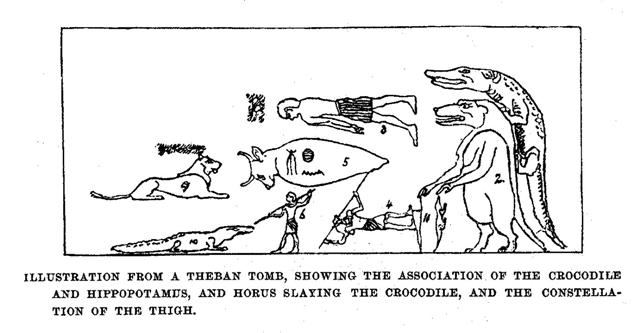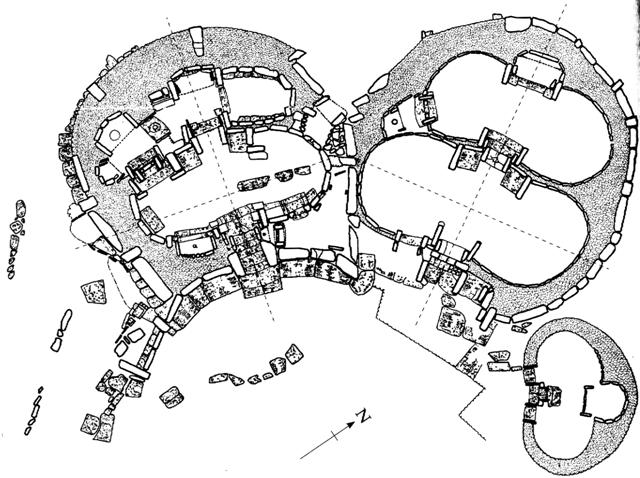|
TRANSLATIONS
This is the 6th period and noon has passed. The sun has started his voyage down towards the western horizon and darkness, illustrated by the Y-sign on top (future). Afternoon is a reversal of morning. The right part of Aa1-26 shows this turn around and the same message is seen in the orientation of tapa mea. The sun in Aa1-26 has another appearance than before noon, it is no longer compressed:
Moreover, before noon his left 'shoulder' (upper right 'flame' seen from us) is like a finger pointing right (seen from us). Now, beginning with the right part of the noon glyph (5) this 'flame' is bent upwards. And also the left 'flame' is similarly bent. The meaning ought to be that sun now is high in the sky. The mid upper 'flame' is converted into the shape of Y. This is a sign similar to the double mid-flame in the first period (1). The similarity in form implies similarity in meaning. Therefore we should understand it to mean 'darkness'. This sun, at a quick glance, looks like an inverted 'fish-sun':
The meaning of 'fish-sun' is that sun is moving quickly (quick as a fish), i.e. he is full of life. If we invert this type of glyph and change the tail of the fish we reach a sun with Y at the top. This, then should mean a sun having no more life, no longer growing. "... ín the second half of life, when, as Dr. Jung has so frequently stated, 'man's values and even his body tend to undergo a reversal into opposite'. Old men become womanish, old women mannish, the fear of life becomes a fear of death. And so now it is the dry branches, not the green, of the universal tree around which the heavens spin that must be grasped and painfully climbed." (Campbell) As regards Aa1-27 we should notice that this reversed tapa mea is exactly as the reversed tapa mea in the 1st period:
And these two reversed signs differ not only in orientation from the normal (in Tahua) tapa mea. The upper group of three marks are oriented more upwards than usual and the one in the middle is longer, not shorter as in tapa mea oriented in the normal direction:
We also can see that the reversed tapa mea are slimmer. Altogether (reversal of the orientation of the glyph, reversal of the length of the mark in the middle of the top three, slimmer 'body', more upwards oriented marks in the top half of the glyph) signifies 'darkness'. At a cardinal point there is no order, i.e. no 'light'. "Chi Khang Tzu asked Master Khung [Confucius] about the art of ruling. The Master said, 'Ruling (cheng, government) is straightening (chêng, rectifying). If you lead a straight way, who will dare go by a crooked one?'" (Needham 2) Order must be banned at a cardinal point, because at such a point there must be change, a disintegration of what has ruled up to that point, a new world of events and habits is due. The world of morning is over and the world of after noon has arrived, filled with events of a different kind than the events of morning. After the cardinal point it will be clear what to do, i.e. vision returns. Light arrives again. The acient Egyptians observed the stars and the circumpolar stars they regarded as qualitatively different from the ordinary stars which arrived at the eastern horizon and later disappeard behind the western horizon. The circumpolar stars had a circular motion, whereas the ordinary ones went straight across the sky. "The inscriptions relating to one of the very earliest of the illustrations refers to Horus, 'the great god, the light of the heavens, the lord of Edfû, the bright ray which appears on the horizon'.
The myth, therefore, I take it, simply means that the rising sun destroys the circumpolar stars. These stars are represented in the earliest forms of the myth either by the crocodile or the hippopotamus; of course they disappeared (or were killed) at sunrise. Horus, the bright ray on the horizon, is victorious by destroying the crocodile and the hippopotamus, which represent the powers of darkness." (Lockyer) Let us now return to Aa1-26. We can observe that hakaturou (Metoro's name for the right part of the glyph) is not only relevant but also quite to the point:
The quadrangular earth has one corner at noon, a prop is located there. From that there is descending, the new rule. The bent toko te rangi (GD32) we should name hakaturu. This hakaturu glyph (right part of Aa1-26), however, has more signs on it than what follows from the bending (GD36). First we notice that the end point is cut off, not tapering off as in e.g. the parallel glyph (Pa5-52) in the Large St Petersburg text:
And then the 'head' part is connected to the sun by a strange sign:
Possibly what is depicted is a toki (GD79), an adze. This adze has cut off the crooked path (as indicated by the cut off end of hakaturu). The adze should signify the rule (of straightness and light and order).
Stone adzes are very old implements, and so are the ideas connected with quadrangular earth. The following (from ancient Malta) is illuminating:
"Then I become aware of ... a presence - a faint, ghostly glimmering, like moonglow, that has appeared on the solstice stone. I don't know how long it lasts, a second or two only I would guess, but while it is there it seems less like a projection - which I know it to be - than something immanent within the stone itself. And it seems to function as a herald for it fades almost as soon as it has appeared and in its place the full effect snaps on - instantaneously. It wasn't there, and then it's there. As Chris had described, the effect does curiously resemble a poleaxe, or a flag on a pole, and consists of a 'shaft', narrow at the base but widening a little towards the top, running up the left hand side of the solstice stone, surmounted by a right-facing 'head' or 'flag'. An instant later an almond-shaped spot of light, like an eye, appears a few centimeters to the right of the 'flag' and the effect is complete. Weirdly - I do not claim it has any significance - this flag-on-a-pole symbol is the ancient Egyptian hieroglyph neter, meaning 'god', or 'a god' - and not to be understood at all in the Judaeo-Christian usage of that word but rather as a reference to one of the supernatural powers or principles that guide and balance the universe. Manifested here, in this strange Stone Age temple, it glows, as though lit by inner fire." (Hancock 2) There is a Chinese / Japanese character meaning 'reform':
At left there is a snake and at right a hand holding a cane or stick. You must kill the snake (old rules and habits) as a first step towards making reforms. This character "originally meant 'drive off serpents' (a symbol of undesirable things), and thus 'clear an area' and hence by extension 'reform' ..." (Henshall) |










